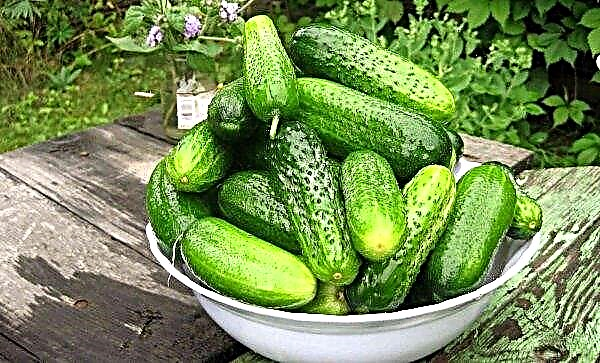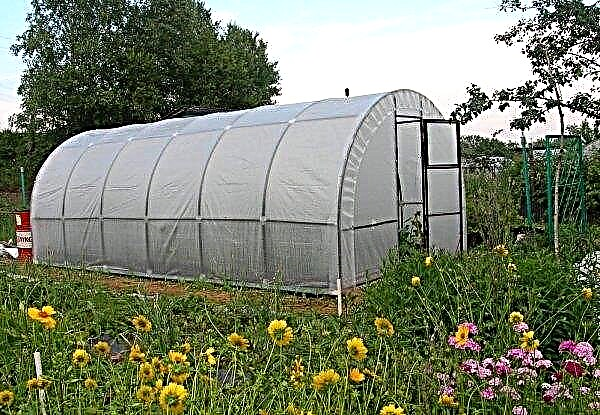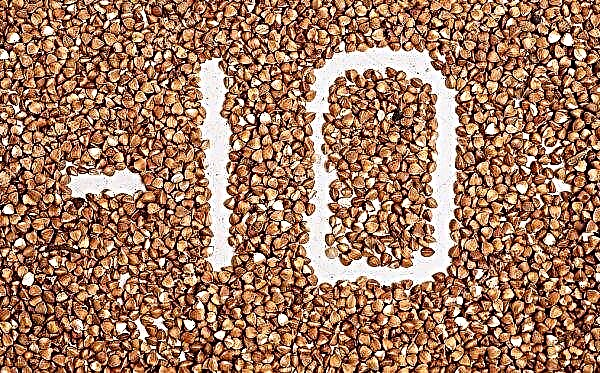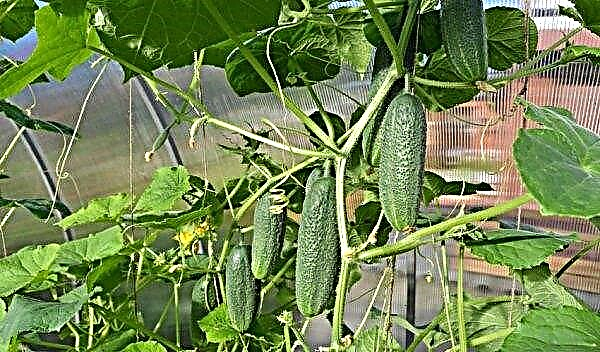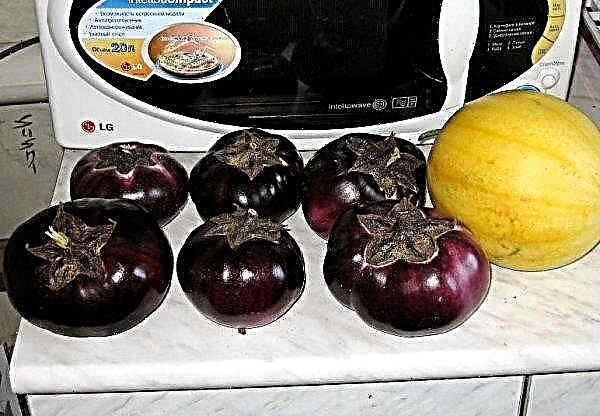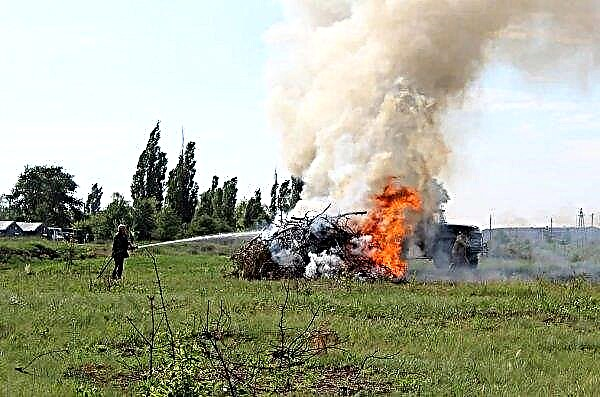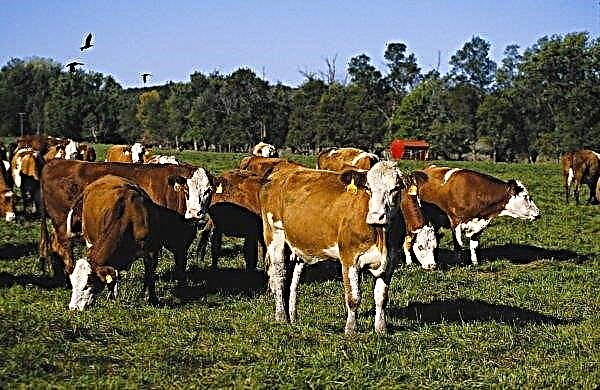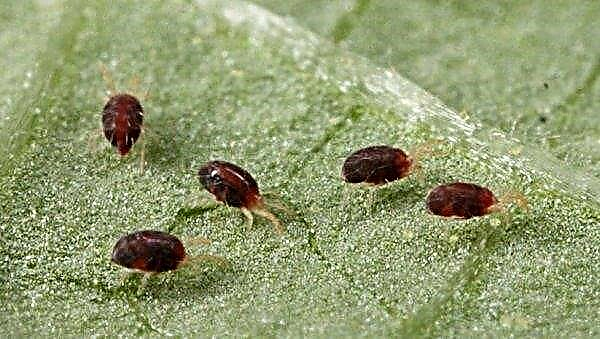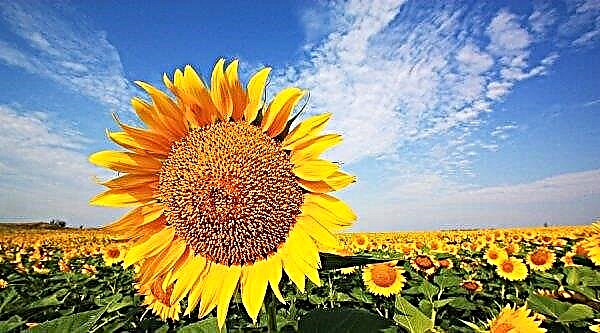Mason begonia is an original plant with a beautiful appearance. It is often used to decorate a house and give a cozy atmosphere. However, like other indoor plants, this species needs special care.
Houseplant Description
Meson begonia is a type of plant of the genus Begonia. Due to its characteristic color, it is also called the Iron Cross. A distinctive feature is leaves with a bright color and a relief surface, the length of which reaches 19-21 cm.
Did you know? On the European continent, this variety was introduced from Singapore in 1952 by Maurice Mason.
In height, this plant grows up to 50 cm. It blooms in small inflorescences, which have a pastel color of a pinkish tint.
| Root system | Rhizome |
| Stem | Fat, fleecy |
| Leaf shape | Heart-shaped, asymmetric |
| Leaf color | The background is light green with dark cross-shaped branches in the form of rays from the base of the leaf. |
| Flower shape | Small, inflorescence panicle |
| Flower color | Beige, pink and white |
Basic rules for planting tubers
After purchase, the tubers of the plant must be planted in a pot or home flower bed. When landing, adhere to the following rules:
- the soil must be loosened, tamping is prohibited;
- planting place - in the center of the pot;
- it is preferable to choose containers made of clay or plastic, the diameter should be 6-8 cm wider than the tuber;
- sprinkle the tuber after being placed in the ground from above with moist soil and watered;
- Until the moment of survival, the container must be closed with a plastic bag.

Optimal conditions for planting and growing
Meson's begonia will grow best if you adhere to the optimal conditions for planting and growing, which are to create the necessary microclimate parameters and follow the rhythms of the plant's vital activity. These include the following items.
- Planting is best done in spring, since the autumn-winter period is characterized by entering dormant mode.
- The correct temperature is considered to be from +18 to +25 ° С. It is important to remember that lowering the indicators below +15 ° C can lead to death.
- The moisture level comfortable for begonia should be at least 60%. Low humidity can cause drying, but excessive moisture can cause bacterial infections.
- The plant needs good lighting, so dark rooms should be avoided. Direct sunlight can also be harmful.
- The soil must be loosened, it must pass air and moisture well.
Home Care
Despite the fact that Meson's begonia is considered a picky plant, it is important not to deviate from the established microclimate and care standards. It is also necessary to pay attention to care in the winter, when the plant hibernates. This season, it may dry slightly. It is recommended to cover the pot with transparent dishes until the development is restored after 2-3 weeks.

Fertilizers
For good growth and maintaining the plant in good condition, it must be fertilized periodically. Top dressing should be done 1 time in 30 days year-round, avoiding dormant periods in the winter season. First, begonia is watered, after which fertilizer is used. For this species, mineral products for indoor plants are suitable.
Important! Fertilizer without prior watering can lead to burns of some parts of the rhizome system.
Watering Rules
Meson's begonia needs moisture, and therefore it needs to be provided with sufficient watering. Water temperature should be from +20 to +25 ° С. Before moistening, the soil should dry by 1.5–2.5 cm. When the plant goes into a dormant period, watering should be reduced and gradually stopped. Moisturizing is resumed after begonia re-enters the activity, which happens approximately 1.5-2 months after hibernation.
Pruning
Pruning is done before transplanting to remove excess leaves. Meson begonia as a decorative and leafy variety needs to get rid of flower stalks. It is allowed to trim in October before moving to a winter dormant period. Damaged and dried parts are cut off immediately.
Transplantation
It is necessary to transplant the plant in order to remove it from the depleted soil and place it in fresh. The frequency should be 1 time in 1-2 years. Also, transplant is resorted to with the development of various diseases. Spring is considered the best time, namely the interval between hibernation and active growth. It is important to avoid the flowering period.
For transplantation, use a spacious pot with a small height and a sufficient diameter so that the roots are spacious. They dig out begonia and carefully clean the root system of the old earth. Drainage (expanded clay or crushed brick) is poured into the tank, the plant is laid down and the soil is poured with loose prepared soil. Then produce watering and drain excess moisture.
Video: how to transplant Mason begonia
Breeding methods
Mason begonia is propagated in two ways: leaf and tuber.
Using leaves
Necessary materials and tools:
- garden knife
- container with substrate or loosened soil;
- plastic bag.
Did you know? The official description of begonia was compiled and published in 1959 Edgar Irscher.
Reproduction should be carried out according to the following instructions.
- A knife is cut with a knife, it is desirable that it is large and with outstanding veins.
- On the veins make incisions.
- The sheet thus treated is placed in a container with a substrate or loosened soil and lightly pressed.
- From above, the container is closed with a plastic bag and placed in a bright place, avoiding direct sunlight.
- Sprouts should appear in the notch area after about 14 days.

Tuber division
Necessary materials and tools:
- garden knife
- coal;
- plastic bag;
- container with a substrate.
Division technology consists of the following steps.
- The garden knife is used to separate parts of the root (up to 6-7 cm) that have buds with a calculation of 1 bud for producing 1 plant.
- Slices are treated with crushed coal.
- The cut off parts are placed in a container with a substrate.
- All containers are placed in a room with a sufficient level of temperature and light, each of them is covered with a plastic bag.
- The frequency of inspection should be no more than 1 time per week, with the appearance of sprouts, the polyethylene is removed.
Diseases and pests
Various diseases in begonias of this species can develop mainly due to a violation of the rules of care. To the defeat of pests has increased humidity and high temperature, but too low rates also harm the plant.
Important! When treating diseased areas with chemicals and self-prepared solutions, do not exceed the permissible dosage consistency in order to avoid burns.
The list of possible diseases includes the following:
- Decay of the root system. The reason is the waterlogging of the soil. At the first signs, namely, a change in the color of some parts of the root to reddish or close to brown, it is necessary to get rid of the rotted areas. It is recommended to treat the tubers with a weakly concentrated solution of potassium permanganate to transplant begonia and to ensure proper care in the future.
- Gray rot. The main symptom is leaf damage to the mold. If you move the pot, the diseased areas easily fall away. For treatment, it is necessary to get rid of the affected parts and treat with a tool like a weak solution of potassium permanganate. If possible, transplant the plant into new soil.
- Shaggy aphids. Another name for the pest is the mealybug. A disease develops when a plant accumulates dust and dirt on itself. A sign of the disease is the appearance of neoplasms in the form of a light fluffy coating on the leaves, mainly in the sinuses. The first help should be the removal of lesions with a soap solution. Next, the owner needs to determine the drug and conduct a treatment course according to the instructions.
- Powdery Mildew This pathology has similar symptoms with hairy aphid damage, however, formations in the form of light plaque spread in small areas on the leaves and on the stem. The reason for the development is the lack of hygiene during cultivation. As a treatment, removal of the affected areas and subsequent treatment with fungicide are undertaken.
- Whitefly The pest of this species looks like a white fly and affects the plant at elevated humidity and temperature. At the first suspicion of a whitefly, begonia should be moved to a room with a drier and cooler microclimate, checked for damage and treated with the appropriate preparation.
- Dry leaves with spots. Mason begonia can dry and stain in the leaf area with increased dryness and low temperature conditions. Dead areas are carefully discarded and the degree of moisture and heat in the room is adjusted.
 Mason begonia is a fairly unpretentious varieties of decorative deciduous begonia, but needs to be maintained in certain conditions. Proper care of the plant will allow you to keep it in the best possible way and at the same time decorate your home with a beautiful and outstanding flowerpot.
Mason begonia is a fairly unpretentious varieties of decorative deciduous begonia, but needs to be maintained in certain conditions. Proper care of the plant will allow you to keep it in the best possible way and at the same time decorate your home with a beautiful and outstanding flowerpot.

